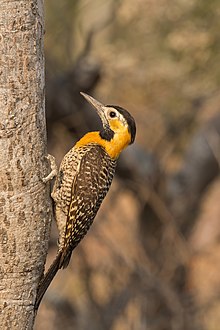Campo flicker
| Campo flicker | |
|---|---|

| |
| female the Pantanal, Brazil | |
| Scientific classification | |
| Kingdom: | Animalia |
| Phylum: | Chordata |
| Class: | Aves |
| Order: | Piciformes |
| Family: | Picidae |
| Genus: | Colaptes |
| Species: | C. campestris
|
| Binomial name | |
| Colaptes campestris (Vieillot, 1818)
| |
The campo flicker (Colaptes campestris) is a species of bird in the woodpecker family. It is found in a wide range of open and semi-open habitats in eastern Brazil, Bolivia, Paraguay, Uruguay and northeastern Argentina, with isolated populations in Amapá and southern Suriname. Though it frequently can be seen in trees or bushes, it is among the very few woodpeckers that spends a significant portion of its life on the ground. It breeds in holes in trees, termite mounds or earth banks. It is generally common and therefore considered to be of least concern by IUCN.
The southern population has a white throat (instead of a black throat) and is sometimes considered a separate species, the pampas flicker (Colaptes campestroides).[2]
Focusing on the breeding aspect of campo flickers, they are "predominantly monogamous in both cooperative group and socially monogamous pairs, but in several cooperative groups, auxiliary females contributed eggs to the next” (Dias et al. 2013). Overall, the studies showed a complex social system in the species with high reproductive conflicts both within and among groups, both due to the new potential breeder or through the effect of group size.
References[]
- ^ BirdLife International (2016). "Colaptes campestris". IUCN Red List of Threatened Species. 2016: e.T22726441A94922382. doi:10.2305/IUCN.UK.2016-3.RLTS.T22726441A94922382.en. Retrieved 11 November 2021.
- ^ Jeannine Miesle (May 11, 2017). "Campo Flickers". beautyofbirds.com. Archived from the original on May 13, 2017. Retrieved May 13, 2017.
3. Dias, Raphael Igor; Webster, Michael S.; Goedert, Débora; Macedo, Regina H. (2013-11). "Cooperative Breeding in the Campo Flicker I". The Condor. 115 (4): 847–854. doi:10.1525/cond.2013.120142. ISSN 0010-5422.[1]
Length: 11.02-12.20 in. (28–31 cm) / Weight: 0.31 lb-0.42 lb (145-192 g)
External links[]
- Colaptes campestris at neotropical.birds.cornell.edu, Archived
- Campo flicker at arkive.org, Archivvary
- ^ Dias, Raphael Igor; Webster, Michael S.; Goedert, Débora; Macedo, Regina H. (November 2013). "Cooperative Breeding in the Campo Flicker I". The Condor. 115 (4): 847–854. doi:10.1525/cond.2013.120142. ISSN 0010-5422.
- IUCN Red List least concern species
- Colaptes
- Birds of Paraguay
- Birds of Bolivia
- Birds of Brazil
- Birds of the Guianas
- Birds of the Pantanal
- Birds of the Caatinga
- Birds of the Cerrado
- Birds described in 1818
- Woodpecker stubs
